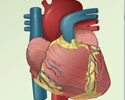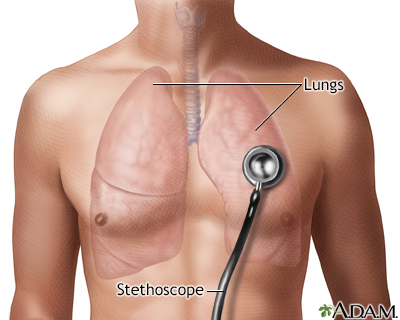Breath sounds
Lung sounds; Breathing soundsBreath sounds are the noises produced by the structures of the lungs during breathing.
Considerations
The lung sounds are best heard with a stethoscope. This is called auscultation.
Normal lung sounds occur in all parts of the chest area, including above the collarbones and at the bottom of the rib cage.
Using a stethoscope, the health care provider may hear normal breathing sounds, decreased or absent breath sounds, and abnormal breath sounds.
Absent or decreased sounds can mean:
- Air or fluid in or around the lungs (such as pneumonia, heart failure, and pleural effusion)
Pneumonia
Pneumonia is inflamed or swollen lung tissue due to infection with a germ. This article covers community-acquired pneumonia (CAP). This type of pneu...
 ImageRead Article Now Book Mark Article
ImageRead Article Now Book Mark ArticleHeart failure
Heart failure is a condition in which the heart is no longer able to pump oxygen-rich blood to the rest of the body efficiently. This causes symptom...
 ImageRead Article Now Book Mark Article
ImageRead Article Now Book Mark ArticlePleural effusion
A pleural effusion is a buildup of fluid between the layers of tissue that line the lungs and chest cavity.
 ImageRead Article Now Book Mark Article
ImageRead Article Now Book Mark Article - Increased thickness of the chest wall
- Over-inflation of a part of the lungs (emphysema can cause this)
Emphysema
Chronic obstructive pulmonary disease (COPD) is a common lung disease. Having COPD makes it hard to breathe. There are two main forms of COPD:Chroni...
 ImageRead Article Now Book Mark Article
ImageRead Article Now Book Mark Article - Reduced airflow to part of the lungs
There are several types of abnormal breath sounds. The four most common are:
- Rales. Small clicking, bubbling, or rattling sounds in the lungs. They are heard when a person breathes in (inhales). They are believed to occur when air opens closed air spaces. Rales can be further described as moist, dry, fine, and coarse.
- Rhonchi. Sounds that resemble snoring. They occur when air is blocked or air flow becomes rough through the large airways.
- Stridor. Wheeze-like sound heard when a person breathes. Usually it is due to a blockage of airflow in the windpipe (trachea) or in the back of the throat.
- Wheezing. High-pitched sounds produced by narrowed airways. They are most often heard when a person breathes out (exhales). Wheezing and other abnormal sounds can sometimes be heard without a stethoscope.
Causes
Causes of abnormal breath sounds may include:
- Acute bronchitis
Bronchitis
Acute bronchitis is swelling and inflamed tissue in the bronchi, the main passages that carry air to the lungs. This swelling narrows the airways, w...
 ImageRead Article Now Book Mark Article
ImageRead Article Now Book Mark Article -
Asthma
Asthma
Asthma is a chronic disease that causes the airways of the lungs to swell and become narrow. It leads to breathing difficulty such as wheezing, shor...
 ImageRead Article Now Book Mark Article
ImageRead Article Now Book Mark Article -
Bronchiectasis
Bronchiectasis
Bronchiectasis is a disease in which the large airways in the lungs are damaged. This causes the airways to become permanently wider. Bronchiectasis...
 ImageRead Article Now Book Mark Article
ImageRead Article Now Book Mark Article - Chronic bronchitis
- Congestive heart failure
-
Emphysema
Emphysema
Chronic obstructive pulmonary disease (COPD) is a common lung disease. Having COPD makes it hard to breathe. There are two main forms of COPD:Chroni...
 ImageRead Article Now Book Mark Article
ImageRead Article Now Book Mark Article -
Interstitial lung disease
Interstitial lung disease
Interstitial lung disease (ILD) is a group of lung disorders in which the lung tissues become inflamed and then damaged.
 ImageRead Article Now Book Mark Article
ImageRead Article Now Book Mark Article - Foreign body obstruction of the airway
-
Pneumonia
Pneumonia
Pneumonia is inflamed or swollen lung tissue due to infection with a germ. This article covers community-acquired pneumonia (CAP). This type of pneu...
 ImageRead Article Now Book Mark Article
ImageRead Article Now Book Mark Article -
Pulmonary edema
Pulmonary edema
Pulmonary edema is an abnormal buildup of fluid in the lungs. This buildup of fluid leads to shortness of breath.
 ImageRead Article Now Book Mark Article
ImageRead Article Now Book Mark Article - Tracheobronchitis
When to Contact a Medical Professional
Seek medical care right away if you have:
-
Cyanosis (bluish discoloration of the skin)
Cyanosis
A bluish color to the skin or mucous membrane is usually due to a lack of oxygen in the blood. The medical term is cyanosis.
 ImageRead Article Now Book Mark Article
ImageRead Article Now Book Mark Article -
Nasal flaring
Nasal flaring
Nasal flaring occurs when the nostrils widen while breathing. It is often a sign of trouble breathing.
 ImageRead Article Now Book Mark Article
ImageRead Article Now Book Mark Article - Severe trouble breathing or shortness of breath
Contact your provider if you have wheezing or other abnormal breathing sounds.
Your provider will do a physical exam and ask you questions about your medical history and your breathing.
Questions may include:
- When did the breath sound start?
- How long did it last?
- How would you describe your breathing?
- What makes it better or worse?
- What other symptoms do you have?
The provider usually discovers abnormal breath sounds. You may not even notice them.
The following tests may be done:
- Analysis of a sputum sample (sputum culture, sputum Gram stain)
Sputum culture
Routine sputum culture is a laboratory test that looks for germs that cause infection. Sputum is the material that comes up from air passages when y...
 ImageRead Article Now Book Mark Article
ImageRead Article Now Book Mark ArticleSputum Gram stain
A sputum Gram stain is a lab test used to detect bacteria in a sputum sample. Sputum is the material that comes up from your air passages when you c...
 ImageRead Article Now Book Mark Article
ImageRead Article Now Book Mark Article - Blood tests (including an arterial blood gas)
Blood gas
Blood gases are a measurement of how much oxygen and carbon dioxide are in your blood. They also determine the acidity (pH) of your blood.
 ImageRead Article Now Book Mark Article
ImageRead Article Now Book Mark Article -
Chest x-ray
Chest x-ray
A chest x-ray is an x-ray of the chest, lungs, heart, large arteries, ribs, and diaphragm.
 ImageRead Article Now Book Mark Article
ImageRead Article Now Book Mark Article -
CT scan of the chest
CT scan
A computed tomography (CT) scan is an imaging method that uses x-rays to create pictures of cross-sections of the body. Related tests include:Abdomin...
 ImageRead Article Now Book Mark Article
ImageRead Article Now Book Mark Article -
Pulmonary function tests
Pulmonary function tests
Pulmonary function tests are a group of tests that measure breathing and how well the lungs are functioning.
 ImageRead Article Now Book Mark Article
ImageRead Article Now Book Mark Article - Pulse oximetry
References
Ball JW, Dains JE, Flynn JA, Solomon BS, Stewart RW. Chest and lungs. In: Ball JW, Dains JE, Flynn JA, Solomon BS, Stewart RW, eds. Seidel's Guide to Physical Examination. 10th ed. St Louis, MO: Elsevier; 2023:chap 14.
Kraft M. Approach to the patient with respiratory disease. In: Goldman L, Schafer AI, eds. Goldman-Cecil Medicine. 26th ed. Philadelphia, PA: Elsevier ; 2020:chap 77.
-
Lungs - illustration
The major features of the lungs include the bronchi, the bronchioles and the alveoli. The alveoli are the microscopic blood vessel-lined sacks in which oxygen and carbon dioxide gas are exchanged.
Lungs
illustration
-
Breath sounds - illustration
Normal lung sounds occur in all parts of the chest area, including above the collarbones and as low as the bottom of the rib cage.
Breath sounds
illustration
-
Lungs - illustration
The major features of the lungs include the bronchi, the bronchioles and the alveoli. The alveoli are the microscopic blood vessel-lined sacks in which oxygen and carbon dioxide gas are exchanged.
Lungs
illustration
-
Breath sounds - illustration
Normal lung sounds occur in all parts of the chest area, including above the collarbones and as low as the bottom of the rib cage.
Breath sounds
illustration
Review Date: 7/8/2023
Reviewed By: Linda J. Vorvick, MD, Clinical Professor, Department of Family Medicine, UW Medicine, School of Medicine, University of Washington, Seattle, WA. Also reviewed by David C. Dugdale, MD, Medical Director, Brenda Conaway, Editorial Director, and the A.D.A.M. Editorial team.





